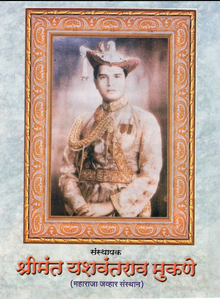List of Koli states and clans
Many parts of Western and Northern regions of the Indian subcontinent were ruled as sovereign or princely states by various clans of Kolis.

Yashwantrao Mukne
Principalities and clans[]

A Koli chieftain
- Mukne Dynasty of Jawhar State[1]
- Bhangare of Devgaon[2]
- Shah of Ramnagar Kingdom[3]
- Raja of Peint[4]
- Pawar Dynasty of Surgana State[5]
- Negi of Koligarh[6]
- Mer of Dhandhuka[7]
- Sord dynasty of Idar[8]
- Chunwalia of Chunwal[9]
- Thorat of Daman and Diu[10]
- Patil of Janjira[11]
- Patil of Guhagar[12]
- Nayak of Sinhagad[13]
- Kagadia of Umrala[14]
- Jalia of Dahewan[15]
- Koli of Sindkhed[16]
Precisely in parts of present Gujarat, several Koli non-salute princely states (generally Hindu) were maintained, enjoying indirect rule under the British raj, notably under these colonial Agencies of British India :
- in Kathiawar :
- Shevdivadar and Vijanones (both petty, single village), held by the Khasia family, in Gohelwar prant
- Jhinjhuvada, including Rozva, in Jhalawar prant
- in Mahi Kantha :
- Hindu Chieftains : Amliyara (Ambliara), Bhalusna, Chandap, Dedhrota, Deloli, Derol, Gabat, Ghorasar, Hadol, Hapa, Ijpura, Ilol, Kadoli, Kasalpura, Gokalpura, Santhal, Katosan, Kheravada, Likhi, Maguna, Memadpura (Mahmadpura), Mulji-Na-Pura, Mota Kotarna, Palej, Prempur, Rampura, Ranipura, Nirmali, Sathamba, Satlasna, Jher, Virsoda, Tejpura, Tajpuri, Timba, Umari, Vakhtapur[17][18]
- Bavisi Thana
- Chieftains converted to Islam : Dabha, Khadal, Punadra[19]
- in Rewa Kantha's Pandu Mehwas division : Angadh, largest Mehwa (single village) of the petty Dorka (e)states and Litter Gothda state[20]
- in Palanpur Agency : Kankrej thana[21][22]
Rulers[]

Yashwantrao Mukne in childhood
- Yashwantrao Martandrao Mukne, Maharaja of Jawhar state[23]
- , ruler of Jawhar state[24]
- , Raja of Jawhar state[25]
- Som Shah, Maharaja of Ramnagar Kingdom and founder of Chauth system[3]
- Jayaba Mukne, founder of Jawhar state and Mukne dynasty[26]
- , ruler of Chhaniar in Chunwal region of Gujarat[9]
- Sonang Mer, Thakor of Dhandhuka[27][28]
- Ramrao Patil, first ruler of Murud-Janjira[11]
- , founder of Khant Dynasty, ruler of Dhandhuka, Dhandhalpur[29]
- Zalim Jalia, Thakor of Dahewan[15]
- Nag Nayak, Rana of Sinhagad[30]
- Qasim Yakut Khan, Patil of Guhagar, Administrator of Janjira and admiral of Mughal Navy[12]
See also[]
References[]
- ^ "Trove of tribal treasures". Deccan Herald. 2019-06-15. Retrieved 2021-01-31.
- ^ Hardiman, David (2007). Histories for the Subordinated. New Delhi, India: Seagull Books. p. 104. ISBN 978-1-905422-38-8.
- ^ a b Sarkar, Jadunath (1992). Shivaji and His Times. Orient Longman. p. 145. ISBN 978-81-250-1347-1.
- ^ Deshpande, Arvind M. (1987). John Briggs in Maharashtra: A Study of District Administration Under Early British Rule. Mittal Publications.
- ^ Waghmare, Abhishek (2018-04-14). "Why Maharashtra farmers walked 170 km and how their strike played out". Business Standard India. Retrieved 2021-01-31.
- ^ Negī, Kuṃvarasiṃha (2001). Gaṛhavāla Maṇḍala kī jānī mānī divaṅgata vibhūtiyam̐ (in Hindi). Kuṃvara Siṃha Negī "Karmaṭha".
- ^ Pfeffer, Georg; Behera, Deepak Kumar (1997). Contemporary Society: Concept of tribal society. Concept Publishing Company. ISBN 978-81-7022-983-4.
- ^ Hunter, William Wilson (1881). Dabha to Harduaganj. Trübner.
- ^ a b Khān, Muḥammad Hāshim Khāfī; Elliot, Sir Henry Miers; Dowson, John (2006). Muntakhab-ul Lubab. Lahore, Pakistan: Sang-e-Meel Publications. p. 44. ISBN 978-969-35-1882-5.
- ^ Verma, Balraj (2006). The Beautiful India - Daman & Diu. Reference Press. p. 10. ISBN 978-81-8405-022-6.
- ^ a b Yimene, Ababu Minda (2004). An African Indian Community in Hyderabad: Siddi Identity, Its Maintenance and Change. Cuvillier Verlag. ISBN 978-3-86537-206-2.
- ^ a b Cāpekara, Nārāyaṇa Govinda (1966). Citpāvana (in Marathi). p. 25.
- ^ Desāī, Rameśa (1987). Shivaji, the Last Great Fort Architect. Maharashtra Information Centre, Directorate-General of Information and Public Relations, Government of Maharashtra. p. 68.
- ^ Roy, Dr. Shivani (1983). Koli culture: a profile of culture of talpad vistar. 24-B, Ansari Road, Daryaganj, New Delhi 110002: Cosmo publications. p. 78.
{{cite book}}: CS1 maint: location (link) - ^ a b Williams, Raymond Brady; Trivedi, Yogi (2016-05-12). Swaminarayan Hinduism: Tradition, Adaptation, and Identity. Oxford University Press. ISBN 978-0-19-908959-8.
- ^ Shrivastavya, Vidayanand Swami (1952). Are Rajput-Maratha Marriages Morganatic?. New Delhi, India: D.K. Shrivastavya Publications. pp. 249 - 250: The Koli chief of Shindkhed who being entangied in feud, was in need of warriors . On learning the encampment of the Jadav brothers in the icinity, he visent his emssary requesting them to help him.
{{cite book}}: CS1 maint: date and year (link) - ^ digital south Asia library. "Imperial Gazetteer on DSAL - Mahi Kantha".
- ^ Gazetteer of the Bombay Presidency: Cutch, Palanpur, and Mahi Kantha. government central press. 1880.
- ^ digital Asia library. "india Princely States : mahi kantha agency".
- ^ digital south Asia library. "indian Princely State". Imperial Gazetteer of India, v. 21, p. 291.
- ^ Gazetteer of the Bombay Presidency: Cutch, Pálanpur, and Mahi Kántha. government central press. 1980.
- ^ digital south Asia library. "palanpur agency princely states".
- ^ Burman, J.J. Roy (1996). "A comparison of sacred groves among the Mahadeo Kolis and Kunbis of Maharashtra". Indian Anthropologist. 26 (1): 37–45. ISSN 0970-0927. JSTOR 41919791.
- ^ Elison, William (2018). The Neighborhood of Gods: The Sacred and the Visible at the Margins of Mumbai. University of Chicago Press. ISBN 978-0-226-49490-6.
- ^ Sarkar, Jadunath (1992). Shivaji and His Times. Orient Longman. pp. 145–47. ISBN 978-81-250-1347-1.
- ^ Nairne, Alexander Kyd (1988). History of the Konkan. Asian Educational Services. ISBN 978-81-206-0275-5.
- ^ Lobo, Lancy (1995). The Thakors of North Gujarat: A Caste in the Village and the Region. Hindustan Publishing Corporation. p. 87. ISBN 978-81-7075-035-2.
- ^ Williams, Raymond Brady; Trivedi, Yogi (2016-05-12). Swaminarayan Hinduism: Tradition, Adaptation, and Identity. Oxford University Press. ISBN 978-0-19-908959-8.
- ^ Pfeffer, Georg; Behera, Deepak Kumar (1997). Contemporary Society: Concept of tribal society. Concept Publishing Company. p. 199. ISBN 978-81-7022-983-4.
- ^ Sharma, Shripad Rama (1951). The Making of Modern India: From A. D. 1526 to the Present Day. Orient Longmans. p. 197.
Categories:
- India-related lists
- Koli people
- Koli princely states
- Koli clans

